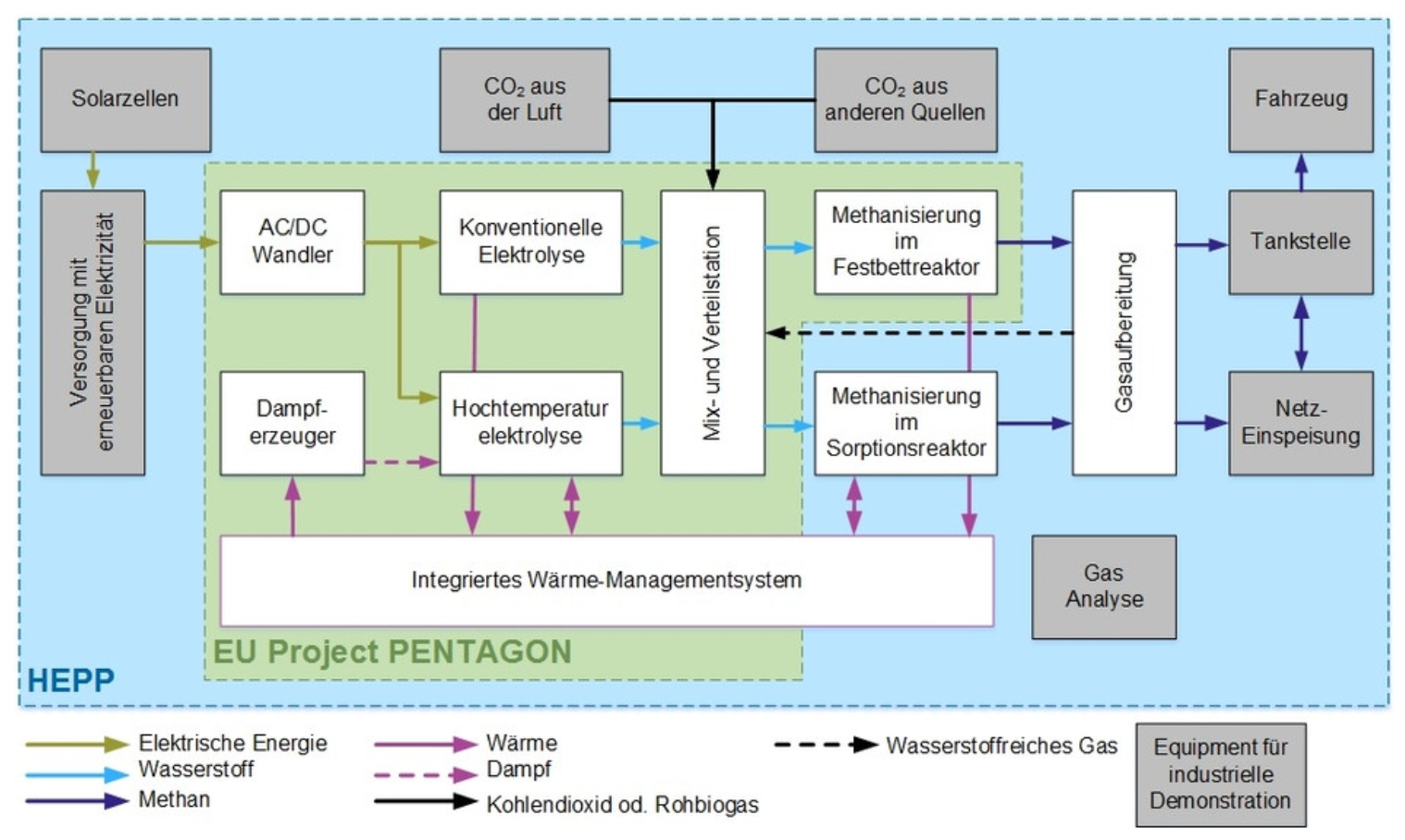Research project
High Efficiency Power-to-Methane Pilot – HEPP
The HEPP (High Efficiency Power-to-Gas Pilot) project will be carried out from 2017 to 2020 and realized through funding from research and industry. The research results will flow into the European Union's Horizon 2020 research framework program in the Pentagon project, which involves a total of ten institutions from academic research and industry from five European countries.
High efficiency with technical innovations
With technical innovations, the experts from the IET Institute of Energy Technology want to increase the technological maturity of power-to-methane technology and demonstrate it on a small scale in a real environment. The innovations in this project relate to efficiency, so that the economic viability of the technology is increased and the environmental impact of the methane produced is reduced. Industrially relevant questions will be answered so that transfer of the technology to a full-scale plant with 70% efficiency is possible.
The core element of the HEPP project is a 10 kW demonstration plant being built in Rapperswil. The plant is equipped with a high-temperature electrolysis system and integrated thermal management. In addition, innovative technologies developed in Switzerland are being integrated into the project for the first time and the system behavior is being investigated.
"The demonstration plant was inaugurated in the fall of 2018 and has since been shown to 1,200 visitors during guided tours. Ongoing projects will continue until mid-2021, with plans to expand the IET's power-to-X activities to include other topics and develop further projects at the facility. Requests for guided tours should be sent to the following email address: besuch-ptx(at)ost.ch.
At the HEPP (High Efficiency Power-to-Methane Pilot) plant, the IET Institute of Energy Technology conducts research and development in the field of power-to-gas, power-to-X.
In 2017, the power-to-gas team started this project with a lot of pioneering spirit. Today, almost four years after the first concept idea, the pioneering spirit is still present at our HEPP plant, only the pioneering romanticism has been partially caught up by everyday life. Specifically, the HEPP plant is now more than two years old and maintenance and servicing work is due. Since the beginning of 2021, the plant has been systematically dismantled, worn parts replaced, measuring equipment sent in and recalibrated. We carry out this maintenance and servicing work firstly so that the HEPP is in perfect condition and we can continue to conduct research with it, and secondly so that we obtain reliable measured values. Of course, like any researcher, we live by the principle that if you measure, you measure nonsense. By checking the measuring equipment, we are trying to significantly reduce the amount of manure.
The work is progressing well, despite certain delays in the delivery of the instruments sent in, so that the HEPP facility can be used for research again in March.
Anecdote:
The research dock was built very compact (rebuilt/expanded), so we couldn't get everywhere with the open-end wrench. One of the maintenance tasks was to retighten the seat seals of our ball valves. To do this, we had to cut various open-end wrenches in half ..... Comment from our workshop: "Do you really want to destroy the beautiful tools?
Conclusion: The open-end wrenches are cut in half and the seat seals are retightened.
Before the maintenance work, we were able to achieve our first small successes in the field of sorption-enhanced methanation (SEM). SEM is also a catalytic methanation process using a special catalyst applied to a zeolite. Conventional methanation catalysts usually have pure aluminum oxide as a support material. Thanks to the properties of the zeolite, this special SEM catalyst produces pure and dry methane at the reactor outlet.
SEM technology had already been tested extensively in the UMTEC laboratories, but integrating this technology into the HEPP plant was not trivial. The challenge was to scale the gas flows from "micro to mini". The solution word for this challenge was bypass. We installed bypasses at various points in the HEPP plant. This allowed us to integrate the UMTEC SEM reactor with micro gas streams into the HEPP plant with mini gas streams. This step enables us to test an operating concept for a power-to-gas plant with SEM catalyst, which was not possible at laboratory scale. The series of tests planned for March/April will provide the design basis for SEM reactor systems with a methane production capacity of 0.5 - 1 Nm³/h. This corresponds to a 200- to 400-fold increase in methane production capacity. This corresponds to a 200- to 400-fold increase in methane production capacity compared to laboratory scale.
Anecdote:
The "beer blanket calculation" is a pragmatic tool which is very popular at applied science colleges. But with this tool you have to watch out for the Popeye error. As with spinach, the decimal place is also relevant when converting units, e.g. that "ml/min" does not suddenly become "liters/min".
Conclusion: Apply the four-eyes principle also for "beer blanket calculation".
One of the central goals that the IET Institute of Energy Technology is pursuing with the HEPP plant is to increase the efficiency of the entire power-to-gas plant. This is to be achieved by coupling the reactor waste heat with a high-temperature electrolysis (SOEC: solid oxide electrolyzer cell). A first intermediate goal could already be achieved here, a first efficiency analysis of the HEPP plant with the PEM electrolysis. In order to achieve the main goal, the IET Power-to-Gas team is working closely with EPFL in Sion. The teams are working on the multi-stage commissioning of the high-temperature electrolysis to ensure that the coupling of the methanation and the SOEC runs as smoothly as possible.
Outlook
In the next IET News we will report in detail about the coupling of the SOEC and the catalytic methanation.






